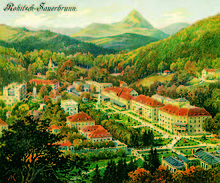Donat Mg
Donat Mg is a natural mineral water from Slovenia . It is named after the nearby Donačka Gora mountain . According to its composition, it is an acid well containing magnesium , sodium , hydrogen carbonate and sulfate . Available in bottles since 1908, when it was first bottled in the spa park in Rogaška Slatina . Donat Mg's logo is the Greek god Apollo .
Source and name
Donat Mg is formed at a depth of 280 to 600 m in the Rogaška Slatina area through the dissolution of rocks rich in magnesium , calcium , sulphates , hydrogen carbonates and other elements. It also contains large amounts of free carbon dioxide. In the 1980s, when research into the effects of minerals, especially magnesium, on the human organism reached its peak in medical science, the symbol for magnesium Mg was added to the name Donat to emphasize the high magnesium content of this natural mineral water.
history
The history of Donat's discovery goes back to 1908, when the heavily mineralized water emerged from a construction pit in the middle of the spa park in Rogaška Slatina. Joseph Knett, the chief geologist in Karlovy Vary in the Czech Republic , had convinced the owners of the springs there to rebuild the reservoirs of the springs, convinced that deeper drilling would lead to larger quantities of the mineral water. The water from the new spring was completely different from the already known water due to its high magnesium content, so it had to be renamed. In addition, special systems were necessary for its therapeutic use in the spa and for bottling.
The new spring had to be protected from the ingress of water from the nearby stream, so concrete sumps for the water were built at the 40 × 8 × 8 meter pit where the spring was located and surrounded by a thick concrete wall. The underground pools were named "Knetteum" in memory of Knett. The water was pumped from these underground basins to the bottling plant and bottled.
In 1931 Adolf Režek, a university professor from Zagreb who supervised the Rogaška sour wells, discovered that the mineral water was demineralizing. The knetteum was not impermeable and could neither prevent the mixing of the mineral water with the water from the nearby stream nor the penetration of rainwater, which was harmful to the spring. For this reason and because of the decline in the productivity of the spring, the decision was made in Rogaška Slatina to thoroughly renovate the spring system soon after the Second World War . Due to the necessity of radical rehabilitation of the facility, a decision was made to carry out risky deep drilling, which the hydrologist Josip Bać from Sarajevo advocated. The Bać concept proved to be correct soon after the drilling began, as on July 6, 1952, large amounts of Donat emerged from a depth of 32 m. The water column was 10 m high.
Between 1952 and 1958, a total of 41 research wells were developed. The boreholes produced a total of around 60 m³ of water per day. After 1958, geological research for new mineral water sources began in the vicinity of Rogaška Slatina. The depth of the boreholes was steadily increased, with the deepest borehole reaching 606 m below the surface of the earth.
Bottling
Donat Mg was initially bottled in the large bottling plant built in Rogaška Slatina in 1904. Before the First World War , 3,000,000 bottles of the mineral water were filled annually. In 1969 the plant reached its maximum filling capacity; therefore, a new bottling plant was opened in 1972, which is still in operation today.
The technology of bottling Rogaška mineral water was quite simple before the construction of the Haybäck bottling plant (before Donat's discovery): the water was bottled directly from the covered spring with ladles. The bottles were then carried in wooden boxes to the central warehouse, where they were checked, corked, appropriately marked, boxed and placed on trolleys.
The filling technology was improved in 1852 when the new large warehouse was built and the so-called Tober pump was installed at the temple spring, which pumped the water through glass pipes to the large collecting basin, where it was filled and packed in boxes. These were then transported to the ramp on rails. From here on everything went according to the old principle, with horse and cart. Only in the new bottling plant was an industrial track laid to the warehouse. Because of the Sauerbrunnen from Rogaška this was connected with the new railway line Grobelno - national border ( Rogatec ).
Donat Mg is now distributed by Droga Kolinska dd , which is part of the Croatian Atlantic Grupa .
| Minerals | Mineralization in g / l |
|---|---|
| Sodium (Na +) | 1.6 |
| Calcium (Ca2 +) | 0.47 |
| Magnesium (Mg2 +) | 1.0 |
| Chloride (Cl-) | 0.1 |
| Sulphate (SO4-2) | 2.25 |
| Bicarbonate | 7.5 |
| Total mineral content | 13 |
Ingredients and effects
In an investigation in 2002, four out of six samples exceeded the permissible arsenic concentration, while the average of the samples remained just below the maximum permissible value. In a later study it was pointed out that since a change in the Mineral Water Ordinance in 2005, a stricter limit value has applied and that special filter technologies have been used by manufacturers since then. At the same time it was pointed out that various sample sets from Donat Mg exceeded the drinking water limit values for boron , nickel and sodium. In a study from 2015 it was shown that a daily amount of 500 ml Donat Mg supports bowel movement and consistency.
Web links
Individual evidence
- ^ Atlantic Grupa signed the agreement acquiring of Droga Kolinska (PDF file).
- ↑ AV Sidel'nikov, DI Dubrovskii, F. Kh. Kudasheva and VN Maistrenko: Identification of mineral waters using impedance spectroscopy and projection to latent structures . In: Journal of Analytical Chemistry . tape 71 , no. 11 , 2016, ISSN 1061-9348 , p. 1166-1171 , doi : 10.1134 / S1061934816110137 .
- ↑ Johannes T. van Elterena, Vekoslava Stibilj and Zdenka Slejkovec: Speciation of inorganic arsenic in some bottled Slovene mineral waters using HPLC-HGAFS and selective coprecipitation combined with FI-HGAFS . In: Water Research . tape 36 , 2002, ISSN 0043-1354 , p. 2967-2974 , doi : 10.1016 / S0043-1354 (01) 00527-9 .
- ↑ Mihael Brenčič, Tamara Ferjan and Mateja Gosar: Geochemical survey of Slovenian bottled waters . In: Journal of Geochemical Exploration . tape 107 , 2010, ISSN 0375-6742 , p. 400-409 , doi : 10.1016 / j.gexplo.2010.09.007 .
- ↑ Gordana Bothe, Aljaz Coh and Annegret Auinger: Efficacy and safety of a natural mineral water rich in magnesium and sulphate for bowel function: a double-blind, randomized, placebo-controlled study . In: European Journal of Nutrition . tape 56 , no. 2 , 2017, ISSN 1436-6207 , p. 491-499 , doi : 10.1007 / s00394-015-1094-8 .


